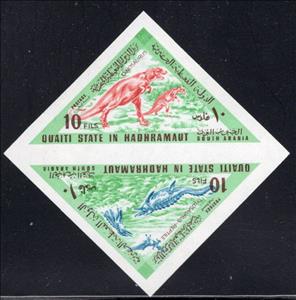Se-tenant: Dinosaurs/Reptiles (Hadhramaut, Qu'aiti (Shihr & Mukalla) 1968)
Dinosaurs/Reptiles (Hadhramaut, Qu'aiti (Shihr & Mukalla) 1968)
01 January (Hadhramaut, Qu'aiti (Shihr & Mukalla) ) within release Animals of the present and prehistoric times goes into circulation Se-tenant Dinosaurs/Reptiles face value 10 South Yemeni fils
| Se-tenant Dinosaurs/Reptiles in catalogues | |
|---|---|
| Michel: | Mi: MI-QSH 179B-180B |
Se-tenant is square format.
Also in the issue Animals of the present and prehistoric times:
- Se-tenant - Brontosaurus/Sharks face value 35;
- Se-tenant - Dinosaurs/Reptiles face value 10;
- Se-tenant - Flying Reptiles/Condors face value 75;
- Se-tenant - Kangaroo/Zebra face value 65;
- Se-tenant - Mastodon/Rhinoceros face value 50;
- Se-tenant - Prehistoric Man/Apes face value 200;
- Se-tenant - Saber-toothed Tiger/Panther face value 5;
Se-tenant Dinosaurs/Reptiles it reflects the thematic directions:
Animals are multicellular, eukaryotic organisms of the kingdom Animalia (also called Metazoa). All animals are motile, meaning they can move spontaneously and independently, at some point in their lives. Their body plan eventually becomes fixed as they develop, although some undergo a process of metamorphosis later on in their lives. All animals are heterotrophs: they must ingest other organisms or their products for sustenance.
Dinosaurs are a diverse group of reptiles of the clade Dinosauria. They first appeared during the Triassic period, between 243 and 233.23 million years ago (mya), although the exact origin and timing of the evolution of dinosaurs is a subject of active research. They became the dominant terrestrial vertebrates after the Triassic–Jurassic extinction event 201.3 mya and their dominance continued throughout the Jurassic and Cretaceous periods. The fossil record shows that birds are feathered dinosaurs, having evolved from earlier theropods during the Late Jurassic epoch, and are the only dinosaur lineage known to have survived the Cretaceous–Paleogene extinction event approximately 66 mya. Dinosaurs can therefore be divided into avian dinosaurs—birds—and the extinct non-avian dinosaurs, which are all dinosaurs other than birds.
Reptiles are tetrapod (four-limbed vertebrate) animals in the class Reptilia, comprising today's turtles, crocodilians, snakes, amphisbaenians, lizards, tuatara, and their extinct relatives. The study of these traditional reptile orders, historically combined with that of modern amphibians, is called herpetology. Because some reptiles are more closely related to birds than they are to other reptiles (e.g., crocodiles are more closely related to birds than they are to lizards), the traditional groups of "reptiles" listed above do not together constitute a monophyletic grouping (or clade). For this reason, many modern scientists prefer to consider the birds part of Reptilia as well, thereby making Reptilia a monophyletic class.
Marine life, or sea life or ocean life, refers to the plants, animals and other organisms that live in the salt water of the sea or ocean, or the brackish water of coastal estuaries. At a fundamental level, marine life helps determine the very nature of our planet. Marine organisms produce much of the oxygen we breathe. Shorelines are in part shaped and protected by marine life, and some marine organisms even help create new land. Altogether there are 230,000 documented marine species, including over 16,000 species of fish, and it has been estimated that nearly two million marine species are yet to be documented. Marine species range in size from the microscopic, including plankton and phytoplankton which can be as small as 0.02 micrometres, to huge cetaceans (whales, dolphins and porpoises) which in the case of the blue whale reach up to 33 metres (109 feet) in length, being the largest known animal.




